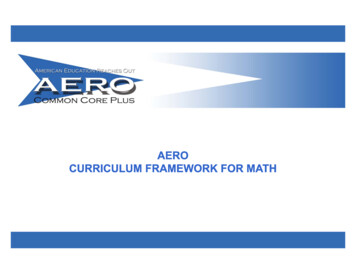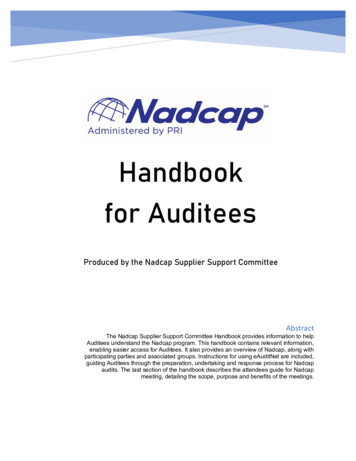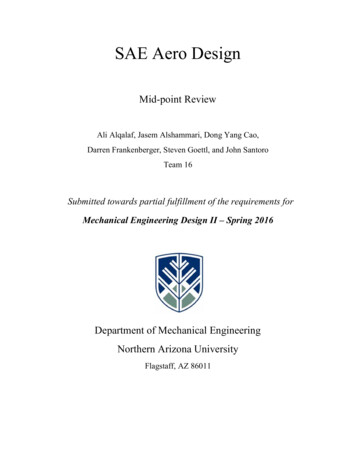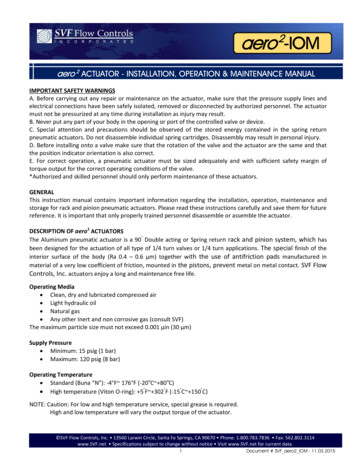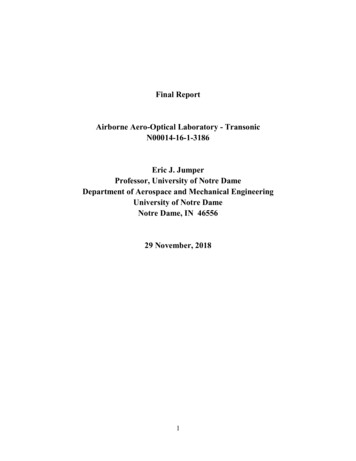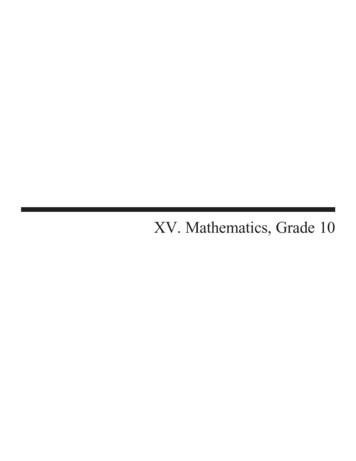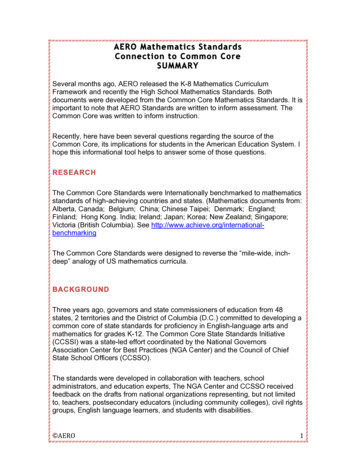
Transcription
AERO Mathematics StandardsConnection to Common CoreSUMMARYSeveral months ago, AERO released the K-8 Mathematics CurriculumFramework and recently the High School Mathematics Standards. Bothdocuments were developed from the Common Core Mathematics Standards. It isimportant to note that AERO Standards are written to inform assessment. TheCommon Core was written to inform instruction.Recently, here have been several questions regarding the source of theCommon Core, its implications for students in the American Education System. Ihope this informational tool helps to answer some of those questions.RESEARCHThe Common Core Standards were Internationally benchmarked to mathematicsstandards of high-achieving countries and states. (Mathematics documents from:Alberta, Canada; Belgium; China; Chinese Taipei; Denmark; England;Finland; Hong Kong. India; Ireland; Japan; Korea; New Zealand; Singapore;Victoria (British Columbia). See e Common Core Standards were designed to reverse the “mile-wide, inchdeep” analogy of US mathematics curricula.BACKGROUNDThree years ago, governors and state commissioners of education from 48states, 2 territories and the District of Columbia (D.C.) committed to developing acommon core of state standards for proficiency in English-language arts andmathematics for grades K-12. The Common Core State Standards Initiative(CCSSI) was a state-led effort coordinated by the National GovernorsAssociation Center for Best Practices (NGA Center) and the Council of ChiefState School Officers (CCSSO).The standards were developed in collaboration with teachers, schooladministrators, and education experts, The NGA Center and CCSSO receivedfeedback on the drafts from national organizations representing, but not limitedto, teachers, postsecondary educators (including community colleges), civil rightsgroups, English language learners, and students with disabilities. AERO1
DESIGNThe Standards are designed to ensure that students graduating from high schoolare prepared to go to college or enter the workforce and that parents, teachers,and students have a clear understanding of what is expected of them.The Standards are benchmarked to international standards to guarantee that ourstudents are competitive in the emerging global marketplace.The Standards create a rigorous definition of college and career-readiness forhigh school graduates.The Standards of Mathematical Practice define the dispositions and habits ofsuccessful mathematical students to ensure College and Career Readiness.The Standards of Mathematical Content define what students should understandand be able to do at each grade level to ensure College and Career Readiness.The Standards are organized under large conceptual domains that span severalgrade levels. Standards are grouped in conceptual clusters under each domain.The Standards: Include rigorous content and application of knowledge throughhigh-order skills;The Standards build upon strengths and lessons of current state standards;The Standards are evidence-based.It is important to note developing a set of common standards is far from lookingfor the lowest common denominator, these Standards are designed to ensurethat all students, regardless of where they live, are learning what they need toknow to graduate from high school ready for college or a career.NATIONAL STANDARDSThe Standards are not national standards. The federal government was NOTinvolved in the development of the standards. This has been a state-led anddriven initiative from the beginning. States will voluntarily adopt the standardsbased on the timelines and context in their state. The process of state standardsadoption depends on the laws of each state. Some states are adopting thestandards through their state boards of education, while others are adoptingthem through their state legislatures. Adoption means the state has agreed 85%of their standards in Math will be from the Common Core. AERO2
POINTS OF EMPHASISAll Gradeso Balance Conceptual Understanding and Procedural Fluencyo Math fact fluency includedo Modeling throughout grade levelsElementary (Kindergarten – 5th Grade)o K-5 standards develop a solid foundation in numbers and operations necessaryto successfully apply more advanced math concepts and procedures in latergrades.o K-5 standards build a grade to grade progression of concepts (e.g. fractions,integers)Middle School (6th to 8th Grade)o Aggressive progression towards preparation for Algebra Io Provide a rich and deep understanding of concepts and application ofmathematics to prepare students for high school mathematics.High School (9th to 12th Grade)o A rigorous definition of College and Career Readiness for all students.Two years beyond traditional Algebra 1 curriculum.o Greater emphasis on functions that current Grade Expectations.o Great emphasis on mathematical modeling in all conceptual domains.o Advanced mathematical standards ( ) are provided to help aligncurriculum up to pre-Calculus level.CURRICULUMThe Standards are not a curriculum. They are a clear set of shared goals andexpectations for what knowledge and skills will help students succeed.Local teachers, principals, superintendents and others will decide how thestandards are to be met. Teachers will continue to develop their scope andsequence, develop units of instruction, devise lesson plans and tailor instructionto the individual needs of the students in their classrooms.Instructional materials and curricula are key components to making standardsusable and real in the classroom. The NGA Center and CCSSO convenedinternationally recognized experts to discuss the implications for curriculum andhow the two organizations could best support districts and states in developingand implementing curricula aligned to the Standards. AERO3
instructionThe best understanding of what works in the classroom comes from the teacherswho are in them. The Standards establish a clear set of shared goals andexpectations for what knowledge and skills will help students succeed, but theydo not dictate how teachers should teach. Teachers will continue to deviselesson plans and tailor instruction to the individual needs of the students in theirclassrooms. However, it is important to note that although the Standards do callfor a change in content the biggest impact will be made by the way we changeinstruction. Local teachers, principals, superintendents and others will decidehow the standards are to be met.ASSESSMENTLike adoption of the standards, assessment is up to the states: The states haveformed two consortia – the Partnership for the Assessment of Readiness forCollege and Careers (PARCC) (www.parcconline.org ) and the SmarterBalanced Assessment Consortium (SBAC) (http://www.k12.wa.us/smarter/ )– toguide the development of new student assessments that are at once morerigorous and more flexible in how they measure learning growth in increasinglydiverse student populations.The goal is to create an assessment system and supporting tools that will helpstates dramatically increase the number of students who graduate high schoolready for college and careers and provide students, parents, teachers andpolicymakers with the tools they need to help students - from grade three throughhigh school - stay on track to graduate prepared. The Partnership will alsodevelop formative tools for grades K-2.The Consortia are grounded in the following principles allow for comparisonacross students, schools, districts, states and nations; create economies ofscale; provide information and support more effective teaching and learning; andprepare students for college and careers. The first assessment is planned for2014. AERO4
Why do we need AERO? Why not just adopt the Common CoreStandards?All states adopting the Common Core have agreed to adopt 100% of the Common Core in threeyears and each state can then decide on an additional 15% to add to the Common CoreStandards. AERO, as did many states used the Common Core to write their standards. AEROdiffers from the Common Core in its presentation and intent. The AERO Standards presents abroad description of the (**learning progression) essential content and general sequencing forstudent learning and skill development at the level of detail of grade-specific curriculum K-8 andcourse specific 9-10. It is written to inform assessment and the AERO MAP assessment isaligned to these learning progressions. See Learning Progressions Frameworks Designed forUse with The Common Core State Standards in Mathematics PF.pdf**Learning progressions characterize typical pathways (obstacles and landmarks) that studentstraverse as they develop proficient understandings of "big ideas" in science, math, and reading.Progressions are based on empirical study of student thinking and link to curriculum, instruction,tools, assessment, and professional SO2 KH08.pdf )Figure 1: Learning progressions connect the “learning zones” of a range of learners withina classroom or grade level. Different instructional materials and strategies will be used byteachers at different points along the learning pathway, but progress is seen as acontinuum of learning. (The Zone of Proximal Development/ZPD is the range of potential eachperson has for learning. Vygotsky (1978) maintained the child follows the adult's example andgradually develops the ability to do certain tasks without help or assistance. He called thedifference between what a child can do with help and what he or she can do without guidance thezone of proximal development.”) "Vygotsky, L.S. (1978). Mind in Society: The Development of Higher Psychological Processes.Cambridge, MA: Harvard University Press.Karin Hess, National Center for the Improvement of Educational Assessment/NCIEA, Dover, NH10/2007, updated 2/2008 AERO5
AERO STANDARDS ALIGNED TO THE COMMON CORE EMPHASISThe standards stress not only procedural skills, but also conceptualunderstanding, to make sure students are learning and absorbing the criticalinformation they need to succeed at higher levels - rather than the currentpractices by which many students learn enough to get by on the next test, butforget it shortly thereafter, only to review again the following year.The K-5 standards provide students with a solid foundation in whole numbers,addition, subtraction, multiplication, division, fractions and decimals--which helpyoung students build the foundation to successfully apply more demanding mathconcepts and procedures, and move into applications.In kindergarten, the standards follow successful international models andrecommendations from the National Research Council’s Early Math Panel report,by focusing kindergarten work on the number core: learning how numberscorrespond to quantities, and learning how to put numbers together and takethem apart (the beginnings of addition and subtraction).The K-5 standards build on the best state standards to provide detailed guidanceto teachers on how to navigate their way through knotty topics such as fractions,negative numbers, and geometry, and do so by maintaining a continuousprogression from grade to grade.Having built a strong foundation K-5, students can do hands on learning ingeometry, algebra and probability and statistics. Students who have completed7th grade and mastered the content and skills through the 7th grade will be wellprepared for algebra in grade 8.The middle school standards are robust and provide a coherent and richpreparation for high school mathematics.The high school standards call on students to practice applying mathematicalways of thinking to real world issues and challenges; they prepare students tothink and reason mathematically.The high school standards set a rigorous definition of college and careerreadiness, by helping students develop a depth of understanding and ability toapply mathematics to novel situations, as college students and employeesregularly do.The high school standards emphasize mathematical modeling, the use ofmathematics and statistics to analyze empirical situations, understand thembetter, and improve decisions. AERO6
WHERE DO WE BEGINBecome familiar with the following critical areas1. The foundation for Mathematics understanding is developed in K-5Adding It UP: How Children Learn Mathematics(http://www.nap.edu/catalog.php?record id 9822)2. College Prep Begins in Middle f/CollegeReadiness.pdf )3. All 9-12 students need rigorous mathematics courses.Ready for College and Ready for Work Same or s/pdf/ReadinessBrief.pdf)Do’s and Don’tsDO: use 2011-12 curriculum time to align curriculum andassessments with AERO K-12See the AERO Alignment templateDO: reassure teachers that it isn’t ‘one more thing’ that theyhave to doDO: encourage K12- teachers to use the standards in planningassessmentsComing soon some examples of the new assessmentsDO: make sure the Mathematical Practices are in place in allclassroomsStandards for Mathematical PracticeMathematical dispositions and habits for all grade levels see AERO HSwww.projectaero.orgDo: inform parents of the importance of developing conceptualas well as procedural understanding of mathematicsDON’T: panic or rush to change everything!Change takes time. We go slow to go fast!DON’T: purchase new textbooks or materials if possible – theyare still evolvingCCSSO is developing a Math curricular analysis tool to help educators analyze curricularmaterials as they implement the math standards. There will be three tools: one looking atthe treatment of key content areas in each of four grade bands (K–2, 3–5, 6–8, 9–12);one analyzing how well the standards for mathematical practice are integrated into thematerials; and one assessing pedagogical aspects of the materials. AERO7
Standards? All states adopting the Common Core have agreed to adopt 100% of the Common Core in three years and each state can then decide on an additional 15% to add to the Common Core Standards. AERO, as did many states used the Common Core to write their standards. AERO differs from the Common Core in its presentation and intent. The AERO .

